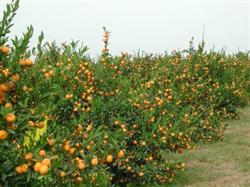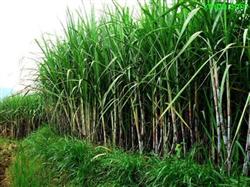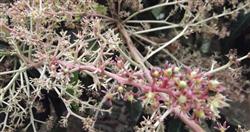High yield technique of early Fruit in three years after planting navel Orange

Navel orange seedlings must be carefully prepared to dig large holes or grooves and fertilize the foot before planting. The survival of the colonized seedlings is mainly through the following measures to promote high yield in the third year. Scientific fertilization. Navel orange seedlings planted in that year can generally survive in half a month. After survival, quick-acting fertilizer is required to be applied every half a month, irrigated with thin manure or 0.5% urea, or 25 grams of urea per plant under the tree plate after rain. After application, the plate is loosened to facilitate root absorption. It is not suitable to apply quick-acting fertilizer after August so as to avoid late autumn shoots. In the second year, topdressing was applied 3 times, and spring, summer and autumn shoot fertilizer was applied again. Spring fertilizer is in the first ten days of February, summer fertilizer is in the first and middle of May, and autumn fertilizer is in the middle and last ten days of July, applying urea 0.2 to 0.4 jin per plant, respectively. After the autumn shoot matured, the base fertilizer was applied again by expanding the hole, applying 10 kilograms of fertilizer per plant, 2 jin of superphosphate and 1 jin of compound fertilizer. In the third year, young trees should increase the application of phosphorus and potassium fertilizer and organic fertilizer to meet the needs of flower and fruit development. 0.4 jin of urea was applied per plant in early February, and extra-root topdressing was carried out every 20 days from April to early August, mainly 0.2% potassium dihydrogen phosphate 0.3% urea + 0.2% borax + zinc sulfate or special micro-fertilizer. Zhuangguo fertilizer was applied to each plant in early July, and back-yang fertilizer was applied in autumn, and gradually cultivated and managed according to the conventional fertilization methods of adult trees. Reasonable shaping and pruning. Young trees must cultivate a good tree shape, do not move branches and pruning, generally use sprouts, thinning, truncation and other methods to promote multiple branches. Specific operation methods: in principle, the first year does not move branches and shears, but only removes disease and insect branches and withered branches; in the second year, the seedlings leave about 25 cm trunk and cultivate 3 to 4 evenly distributed main branches in the plastic zone above the trunk. To do a good job of two summer pruning, the first cut 1/3 of the mature spring shoots on the periphery of the crown in mid-May to promote strong summer shoots, and the second method of slightly coring the mature summer shoots on the periphery of the crown in mid-July, leaving 6 or 8 leaves in the summer shoots in the middle of June, which lasted until the middle of July, the inner bore branches of the drooping branches were preserved as far as possible, and the cords with dense crowns and half of the wild growth of the crown could be used to pull open the trunk of 2 or 4 branches. In the second year, flower buds should be erased in time, and in the third year, flowers should be thinned, leafless flowers and deformed flowers should be removed, diseased branches should be cut off, and some fruit protection measures should be taken at the same time. The yield per plant is generally controlled at about 5 kg to 8 kg, and the excess fruit should be erased. Assistant management. After the seedlings are planted, the tree plate should be covered with rice and wheat straw to protect the seedlings. In winter, before the cold wave comes, you can use a large convenience bag to cover the seedlings or cover the branches with straw and paint the trunk with whitening agent. The orchard advocates intercropping legume crops or adopting the way of growing grass in the orchard. The control of diseases and insect pests is basically the same as that of adult trees. In the third year, corresponding measures for flower thinning and fruit protection should be taken to ensure early and high yield in that year.
- Prev

How to apply fertilizer for high yield of sugarcane
Sugarcane has a long growth period and high yield. It can generally produce 5000-8000 kg of sugarcane per mu. It absorbs more nutrients during the whole growth period and is one of the crops that need a large amount of fertilizer. According to research, for every 1000 kg of sugarcane, it is necessary to absorb 1.5-2kg of nitrogen, 1-1.5kg of phosphorus, 2-2.5kg of potassium and 0.75 of calcium from the soil.
- Next

Key points of flower and fruit management in mango orchard
(1) use of plant growth regulators: plant growth regulators must be used in accordance with the prescribed concentration, method and time of use, and plant growth regulators registered and produced without the approval of the State shall not be used. As a plant growth regulator for controlling shoots and promoting flowers, the recommended concentration is ethephon 200 ~ 3.
Related
- Moge, come on! The staff of the peasant association in the producing area of cantaloupe were frightened when the crowd gathered.
- Causes and Solutions of low Fruit setting rate of Apple
- Symptoms and control measures of passion fruit virus disease
- Fruit growing lesson: how do apple orchards keep high yields?
- Can you build orchards in the mountains? What are the pros and cons?
- How to manage the coloring period of Crisson grape?
- This paper introduces the processing technology of two kinds of fig products.
- How much is a month for retired teachers in rural areas by 2020?
- How can strawberry planting increase sugar content? We should pay attention to management in many aspects.
- What are the cultivation techniques on how to improve the yield of golden fruit?

